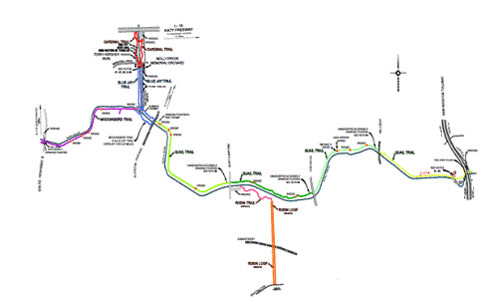OK, so you're not one of the bony types who hang out in the break room at the office hitting up all their co-workers for a pledge to this year's 180-mile BP MS150 between Houston and Austin. You don't own a single item of Spandex®, and your bike weighs about the same as a set of the Encyclopedia Britannica. That doesn't mean you can't get out on your bike and enjoy the fresh air while you get some exercise. If you live or work near Houston's Energy Corridor, you have a great opportunity right at your doorstep: the
Terry Hershey Trail.
Managed by Harris County Precinct 3, the paved trail follows the banks of Buffalo Bayou from the foot of the Addicks Dam (at George Bush park) to a terminus at the Sam Houston Tollway (Texas 8), a distance of some 6.5 miles. In 2013, the county added an arm to the trail that provides access to the Addicks Park-n-Ride lot. The main trail is separated into five more or less equal sections by major north-south streets: from the West, they are Eldridge parkway, Dairy Ashford Road, Kirkwood Road, and Wilcrest Drive.
Section 1 - Bush Park to Eldridge Parkway
The trail runs along the south side of Buffalo Bayou through a lightly wooded area. There are several bridge crossings at small drainages: watch for a "step" of up to an inch where the path meets the concrete pad (the precinct fills these occasionally, but they soon redevelop). At about one mile, a footbridge across the Bayou (see right) leads to the 500-acre Terry Hershey Park on Memorial Drive. That path loops back to meet the main Hershey Trail just west of Eldridge, about a one-mile loop. There are drinking fountains (human and dog) along the loop trail and even a shower to help cool down runners.
The west end of the so-called "anthill," used by fat-tire enthusiasts, parallels the paved trail off to the right (south) through this section. After a rain, be wary of heavy mud coating the trail in spots where the off-road trails veer to the side and uphill.
Parking is available north of the Bayou on the west side of Texas 6. To reach the trailhead, you must cross the Highway 6 bridge on a narrow, one-lane sidewalk. Parking is also available at the park on the north side of Memorial as well as along Memorial Mews south of Memorial. Restrooms, water, and picnic tables are available at the park; only picnic tables can be found at the western end and a water fountain near the zero mile marker.
Section 2 - Eldridge Parkway to Dairy Ashford Road
|
|
The trail runs along the north side of the Bayou from the east side of Eldridge to the other end. Eastbound cyclists can reconnect with the main trail by crossing the Bayou on the Eldridge bridge (only wide enough for one bicycle!) and turning left to loop under the roadway. A restroom with drinking fountains sits just east of Eldridge, and you can also connect with a bicycle route that follows Enclave Parkway. This section of the trail is also mostly flat, though there are a few slight inclines and several sharp turns.
Parking is available at Dairy Ashford on the south side of the Bayou; to reach the trail you must cross the bridge either on the road surface (not a good idea) or on an open sidewalk. At the west end, some folks park in the Kendall Library lot on the northwest corner of Eldridge and the Bayou (preferably when the library is closed). There are no restroom facilities in this section, nor is there water. Benches and picnic tables can be found all along the paved trail. |
There is access to the Robin Trail, a 1.8-mile loop (mostly crushed granite) at the east end of the Dairy Ashford parking lot. The Robin Trail connects with a city bicycle lane on Briar Forest Drive, about half a mile south. If mud's your thing, you can connect with the dirt trails through the woods on the south side of the Bayou by dropping down the banks on the east side of the bridge.
Trail Etiquette
| Cyclists must yield the right of way to everyone, even if they're hogging the trail. Watch for loose dogs (in defiance of park rules) and new moms weaving around with strollers while texting. Be safe: announce your presence to pedestrians and other cyclists before passing, and never stop and stand on the trail. |
|
|
Coming Next: The rest of the trail...
copyright © 2016-2017 scmrak










